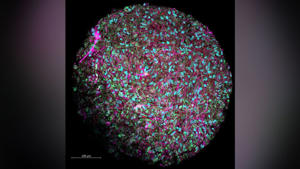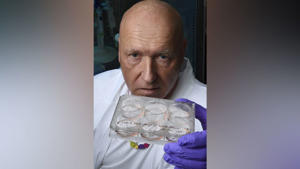
Computers powered by human brain cells may sound like science fiction, but a group of American researchers believe such machines, part of a new field called organoid intelligence, can shape the future, and now they have plans to make it happen.
Organoids are lab-grown tissues that resemble organs. These three-dimensional constructs, usually derived from stem cells, have been used in laboratories for nearly two decades, where scientists experiment with substitutes for kidneys, lungs, and other organs to avoid dangerous experiments on humans or animals.
The brain's organelles don't actually look like miniature versions of the human brain, but cell cultures the size of a pencil point contain neurons that can perform brain-like functions by forming lots of connections.
Scientists call this phenomenon "intelligence on a plate."
 © Provided by CNN. This enlarged image shows brain organelles obtained in Hartung's laboratory. Cultured neurons are stained to show red, cell nuclei in blue, and other accessory cells in red and green. – Courtesy of Jesse Plotkin/Johns Hopkins University
© Provided by CNN. This enlarged image shows brain organelles obtained in Hartung's laboratory. Cultured neurons are stained to show red, cell nuclei in blue, and other accessory cells in red and green. – Courtesy of Jesse Plotkin/Johns Hopkins University
Professor of Health and Environmental Engineering at the Johns Hopkins Bloomberg School of Public Health and the Whiting School of Engineering in Baltimore. In 2012, Thomas Hartung began growing brain organelles by modifying human skin samples.
He and his colleagues propose harnessing the power of brain organelles into a kind of biological hardware that is more energy efficient than a supercomputer. This "biocomputer" will use a network of brain organelles to revolutionize pharmaceutical tests for diseases such as Alzheimer's, providing insight into the human brain and changing the future of computing.
Hartung and colleagues' study, which describes the organoid exploration plan, was published Tuesday in the journal Frontiers in Science.
"Computers and artificial intelligence are driving the technological revolution, but they have reached their limits," said Hartung, the study's lead author. "Biocomputing is a major endeavor to harness computing power and drive efficiencies beyond the limitations of our current technology."
Human brain versus artificial intelligence
Although artificial intelligence is inspired by human thought processes, the technology cannot fully replicate all the capabilities of the human brain. Because of these vulnerabilities, people can use image- or text-based CAPTCHAs, or use fully automated public Turing tests to distinguish between computers and humans as an Internet security measure to prove they are not bots.
The Turing test, also known as the imitation game, was developed in the 1950s by British mathematician and computer scientist Alan Turing to assess how well machines exhibit human-like intelligent behavior.
But how can computers defend against human brains?
Supercomputers can process numbers faster than humans.
"For example, AlphaGo [the AI that beat the world's No. 1 Go player in 2017] was trained based on data from 160,000 games," said Hartung. "One would have to play five hours a day for over 175 years to experience so much play."
On the other hand, the human brain is more energy efficient and also better at learning and making complex logical decisions. Basic things like distinguishing one animal from another is something that the human brain can easily handle, but computers cannot.
The $600 million supercomputer at Oak Ridge National Laboratory in Frontier, Tennessee weighs 8,000 pounds (3,629 kg), with each cabinet weighing the equivalent of two standard trucks. In June, the machine surpassed the processing power of a single human brain, Hartung said, but used a million times more energy.
"The brain is still unique in modern computers," said Hartung.
"The brain also has an extraordinary capacity to store about 2,500 (terabytes) worth of information," he added. "We have reached the physical limit of silicon computers in that we cannot fit more transistors onto a smaller chip."
How do biocomputers work?
Stem cell pioneers John B. Gordon and Shinya Yamanaka received the 2012 Nobel Prize for developing a method for generating cells from mature tissue such as skin. Basic research has allowed scientists like Hartung to create brain organoids that can be used to mimic a living brain and to test and identify drugs that may pose a risk to brain health.
 © Courtesy of CNN Hartung has worked with brain organelles for years. – Contributed by Will Kirk/Johns Hopkins University.
© Courtesy of CNN Hartung has worked with brain organelles for years. – Contributed by Will Kirk/Johns Hopkins University.
Hartung recalls other researchers asking whether brain organelles could think or be conscious. This question made him think about how to provide organelles with information about the environment and how to interact with it.
"This opens up opportunities to study how the human brain works," said Hartung, who is also co-director of the Center for Alternatives to Animal Experiments in Europe. "Because you can start to manipulate the system and do things to the human brain that you can't do ethically."
Hartung defines organoid intelligence as “the replication of cognitive functions such as learning and sensory processing in laboratory-developed models of the human brain.”
The brain organelles that Hartung currently uses must be added for OI, or organelle intelligence. Each organelle consists of the same number of cells as the fruit fly's nervous system. The size of the organoid is equivalent to about one-thirty million human brains, which equates to a storage capacity of about 800 megabytes.
“They are very small, about 50,000 cells each. "We need to increase this amount to 10 million for OI," he said.
Researchers also needed a way to communicate with organisms to transmit information and learn about what those organisms were "thinking". The research authors developed a plan that included bioengineering and machine learning tools, as well as new innovations. Allowing different types of inputs and outputs in organelle networks would enable more complex tasks, the researchers wrote in the study.
“We developed a brain-computer interface device with a kind of EEG (electroencephalogram) cover for organelles. We presented it in a paper published last August,” said Hartung. "It's a flexible, hermetically sealed shell with tiny electrodes that can pick up signals and send signals to organs."
Hartung hopes that one day there will be a useful channel of communication between artificial intelligence and artificial intelligence, "allowing them to discover each other's capabilities."
How to use OI
The researchers say that the most important contribution of organoid intelligence may be in human medicine.
Brain organoids can be made from skin samples of patients with neurological diseases, allowing scientists to test how various drugs and other factors might affect them.
"With the help of AI, we can also investigate the cognitive aspects of neurological diseases," said Hartung. "For example, we can compare memory formation in the organelles of healthy people and Alzheimer's patients and try to correct for relative deficiencies. We can also use artificial intelligence to test whether certain substances, such as pesticides, cause memory or learning problems."
Brain organelles may also open up new ways of understanding human cognition.
"We wanted to compare brain organelles from an autistic donor and brain organelles from a normally developing donor," Lena Smirnova, professor of environmental health and engineering at Johns Hopkins University, said in a statement.
“The tools we developed for Biological Computing are the same tools that will help us understand the neural network changes that are characteristic of autism without using animals or referring patients, so we can understand why patients develop these cognitive problems. and distractions," he said.
The use of brain organelles to create organoid intelligence is still in its infancy. Hartung said it would take decades to create computer-like artificial intelligence with the intelligence of mice.
But there are already promising results that suggest it's possible. The study's co-author, Dr. Brett Kagan, senior scientist at Cortical Laboratories in Melbourne, Australia, and his team recently showed that brain cells can learn to play a video game called Pong.
"Your team has tested it with brain organelles," said Hartung. “And I would say that replicating these experiments with organisms is within the basic definition of AI. Therefore, it is simply a matter of creating the community, tools and technology to realize the full potential of AI."
Ethics of brain organelles
Making human brain organelles cognitive raises a number of ethical questions, including whether they can develop consciousness or feel pain and whether the people whose cells are used to create them have the right to own those organelles.
"An important part of our vision is developing OI in an ethical and socially responsible way," said Hartung. “That's why we've been working with ethicists from the start to take an integrated ethics approach. All ethical issues are continuously evaluated as investigations continue by a panel of scientists, ethicists and the public."
Julian Kindler, emeritus professor of intellectual property law at the University of Cape Town, South Africa, wrote in a separate Policy Perspective that public engagement is critical to understanding and developing AI. Pediatric teachers were not involved in the new OI study.
"We are entering a new world where human interaction is blurring boundaries," Kindler wrote. “Society cannot passively wait for new discoveries; It should identify and resolve potential ethical dilemmas and ensure that all practices are within ethical boundaries.
"The rise of artificial intelligence like ChatGPT has made some people wonder how close computers are to passing the Turing test," wrote Gary Miller, dean for research and innovation strategy and professor of environmental health sciences at Columbia University in New York. The "Perspective" article was published on Tuesday. Miller was not involved in the Johns Hopkins research.
 © CNN Brain organelles may one day be used to power biocomputers. – Contributed by Will Kirk/Johns Hopkins University.
© CNN Brain organelles may one day be used to power biocomputers. – Contributed by Will Kirk/Johns Hopkins University.
He writes that while ChatGPT can collect data efficiently over the internet, it cannot respond to changes in temperature like cultured cell systems.
"Organic systems in the brain may represent fundamental aspects of intelligence and emotion," writes Miller.
"It's morally strong, and where we're always going to be scientific. and and and and and and and and and and and and and and and and and and and and and and and and and and and and and and and and and and and and and and and and and and and and and and and and and amount and amount.
cnn
